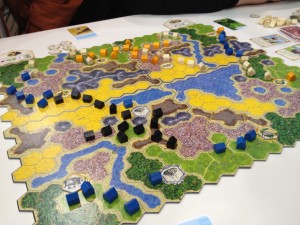Review: Kingdom Builder
Posted by James (admin) on September 1st, 2012
K ingdom Builder is designed by the designer of Dominion and went on to win the coveted Spiel des Jahres award 2012. The game is relatively simple. Players score points at the end of the game based on where they have built their buildings based on criteria specified by 3 Kingdom Builder cards (randomly selected from 10). The board is created using 4 sections in any combination (randomly selected from 8).
ingdom Builder is designed by the designer of Dominion and went on to win the coveted Spiel des Jahres award 2012. The game is relatively simple. Players score points at the end of the game based on where they have built their buildings based on criteria specified by 3 Kingdom Builder cards (randomly selected from 10). The board is created using 4 sections in any combination (randomly selected from 8).
On their turn, a player has just one terrain card and they must place 3 of their buildings on unoccupied spaces on the board that match that terrain type. Buildings must be placed next to any of the player’s existing buildings, if possible; otherwise, they can be placed on any hexes of the matching terrain. If the player places any of their buildings next to one of the special locations on the board, they get to take one of the matching special action tiles.
As well as the mandatory action, players can use any special actions they have collected which allow a player to do things like moving buildings and building an extra buildings. The special actions can each be used once per turn.
The end of the game is triggered when one player has placed all of their buildings on the board. Players get points based on the Kingdom Builder cards, plus 3 for every castle on the board that a player has built next to.
 Overall, Kingdom Builder sounds like a perfect recipe for a great game (designer of Dominion and the Spiel des Jahres). It definitely fits the Spiel des Jahres extremely well as it’s an easily accessible game, simple to learn, friendly theme and is a little bit different. However, I’m not convinced it’s for all gamers.
Overall, Kingdom Builder sounds like a perfect recipe for a great game (designer of Dominion and the Spiel des Jahres). It definitely fits the Spiel des Jahres extremely well as it’s an easily accessible game, simple to learn, friendly theme and is a little bit different. However, I’m not convinced it’s for all gamers.
There can be some really interesting decision-making as each building you place can change which terrains your buildings are adjacent to and, therefore, change where you can (or must) place your next buildings. Also, you need to keep thinking about the 3 points scoring cards too. As you must build adjacent to your existing buildings, you often try to ensure you have no buildings next to certain terrains so you can build in a specific hex elsewhere on the board.
The production quality is great (as usual with Queen’s games) and there’s lots of variety in replay due to the combination of board sections and especially the different scoring cards (although it feels a little bit expensive for the depth of game you get – it seems all Queen Games seem to have gone up in price a lot in recent years).
However, the key problem for me is the one terrain card at a time rule because it means that luck is a very large factor. Light gamers, families and casual gamers will probably not notice (or care about) this, but I think it’ll be an issue for regular gamers. In the first game we played at Spiel 2011, one of our players ended up with no decisions to make as they kept drawing terrain cards that meant they could only build in one single location – and that’s not playing a game, that’s the game playing you. Even if you can build in a few places, it’s very annoying to finish your turn after having a card that wasn’t uvery seful, and then draw a new card to find it’s the same card you had last turn. Also, one card at a time means you can’t plan your turn to link with your next turn, i.e. you would have done things differently if you knew what card you were going to get next.
To reduce this luck factor (and to allow a bit of planning ahead), I thought the game should be played with a hand of 2 or 3 cards (in the same way Carcassonne can be played) – it turns out this is one of the unofficial variants. The more cards a player has in their hand, the more chance of over-analysis and a slower game, but I think 2 or 3 cards would be a good balance.
As a result, I want to play Kingdom Builder some more as I had a fairly good experience (my cards gave me interesting decisions) but I will always play with the rule that we will have hands of 2 or 3 cards.
I suggest gamers that like deeper games try it out before they buy it; however, I can see why it won the Spiel des Jahres and think it’s a clever game design which may be the simple grail game that encourages your partners or family to play board games.
James.
[Played with 4 players]

